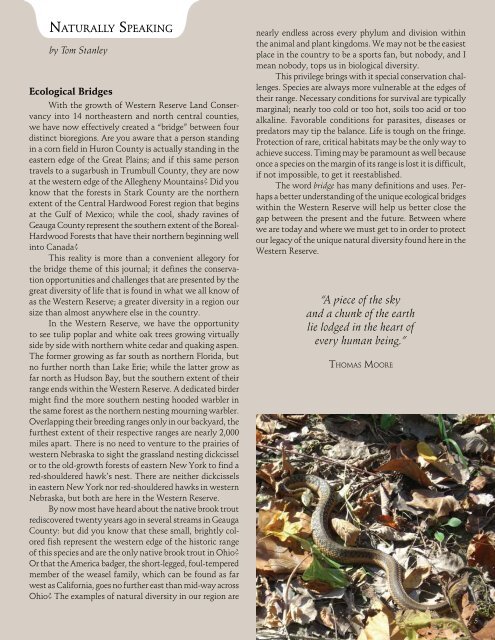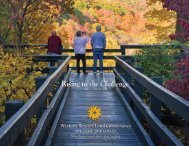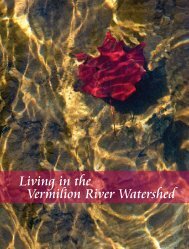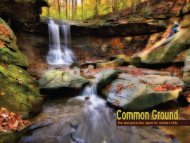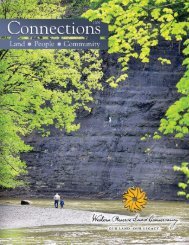SPRING 2008 - Western Reserve Land Conservancy
SPRING 2008 - Western Reserve Land Conservancy
SPRING 2008 - Western Reserve Land Conservancy
Create successful ePaper yourself
Turn your PDF publications into a flip-book with our unique Google optimized e-Paper software.
Nat u r a l ly Sp e a k i n gby Tom StanleyEcological BridgesWith the growth of <strong>Western</strong> <strong>Reserve</strong> <strong>Land</strong> <strong>Conservancy</strong>into 14 northeastern and north central counties,we have now effectively created a “bridge” between fourdistinct bioregions. Are you aware that a person standingin a corn field in Huron County is actually standing in theeastern edge of the Great Plains; and if this same persontravels to a sugarbush in Trumbull County, they are nowat the western edge of the Allegheny Mountains? Did youknow that the forests in Stark County are the northernextent of the Central Hardwood Forest region that beginsat the Gulf of Mexico; while the cool, shady ravines ofGeauga County represent the southern extent of the Boreal-Hardwood Forests that have their northern beginning wellinto Canada?This reality is more than a convenient allegory forthe bridge theme of this journal; it defines the conservationopportunities and challenges that are presented by thegreat diversity of life that is found in what we all know ofas the <strong>Western</strong> <strong>Reserve</strong>; a greater diversity in a region oursize than almost anywhere else in the country.In the <strong>Western</strong> <strong>Reserve</strong>, we have the opportunityto see tulip poplar and white oak trees growing virtuallyside by side with northern white cedar and quaking aspen.The former growing as far south as northern Florida, butno further north than Lake Erie; while the latter grow asfar north as Hudson Bay, but the southern extent of theirrange ends within the <strong>Western</strong> <strong>Reserve</strong>. A dedicated birdermight find the more southern nesting hooded warbler inthe same forest as the northern nesting mourning warbler.Overlapping their breeding ranges only in our backyard, thefurthest extent of their respective ranges are nearly 2,000miles apart. There is no need to venture to the prairies ofwestern Nebraska to sight the grassland nesting dickcisselor to the old-growth forests of eastern New York to find ared-shouldered hawk’s nest. There are neither dickcisselsin eastern New York nor red-shouldered hawks in westernNebraska, but both are here in the <strong>Western</strong> <strong>Reserve</strong>.By now most have heard about the native brook troutrediscovered twenty years ago in several streams in GeaugaCounty: but did you know that these small, brightly coloredfish represent the western edge of the historic rangeof this species and are the only native brook trout in Ohio?Or that the America badger, the short-legged, foul-temperedmember of the weasel family, which can be found as farwest as California, goes no further east than mid-way acrossOhio? The examples of natural diversity in our region arenearly endless across every phylum and division withinthe animal and plant kingdoms. We may not be the easiestplace in the country to be a sports fan, but nobody, and Imean nobody, tops us in biological diversity.This privilege brings with it special conservation challenges.Species are always more vulnerable at the edges oftheir range. Necessary conditions for survival are typicallymarginal; nearly too cold or too hot, soils too acid or tooalkaline. Favorable conditions for parasites, diseases orpredators may tip the balance. Life is tough on the fringe.Protection of rare, critical habitats may be the only way toachieve success. Timing may be paramount as well becauseonce a species on the margin of its range is lost it is difficult,if not impossible, to get it reestablished.The word bridge has many definitions and uses. Perhapsa better understanding of the unique ecological bridgeswithin the <strong>Western</strong> <strong>Reserve</strong> will help us better close thegap between the present and the future. Between wherewe are today and where we must get to in order to protectour legacy of the unique natural diversity found here in the<strong>Western</strong> <strong>Reserve</strong>.“A piece of the skyand a chunk of the earthlie lodged in the heart ofevery human being.”Th o m a s Mo o r e5


